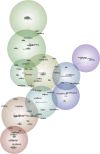Messaging and Information in Mental Health Communication on Social Media: Computational and Quantitative Analysis
- PMID: 40608453
- PMCID: PMC12244273
- DOI: 10.2196/48230
Messaging and Information in Mental Health Communication on Social Media: Computational and Quantitative Analysis
Abstract
Background: Mental health organizations have the vital and difficult task of shaping public discourse and providing important information. Social media platforms such as X (formerly known as Twitter) serve as such communication channels, and analyzing organizational health information offers valuable insights into their guidance and linguistic patterns, which can enhance communication strategies for health campaigns and interventions. The findings inform strategies to enhance public engagement, trust, and the effectiveness of mental health messaging.
Objective: This study examines the predominant themes and linguistic characteristics of messages from mental health organizations, focusing on how these messages' structure information, engage audiences, and contribute to public information and discourse on mental health.
Methods: A computational content analysis was conducted to identify thematic clusters within messages from 17 unique mental health organizations, totaling 326,967 tweets and approximately 7.2 million words. In addition, Linguistic Inquiry and Word Count (LIWC) was used to analyze affective, social, and cognitive processes in messages with positive versus negative sentiment. Differences in sentiment were assessed using a Mann-Whitney U test.
Results: The analysis revealed that organizations predominantly emphasize themes related to community, well-being, and workplace mental health. Sentiment analysis indicated significant differences in affect (P<.001), social processes (P<.001), and cognitive processing (P<.001) between positive and negative messages, with effect sizes that were small to medium. Notably, while messages frequently conveyed positive sentiment and social engagement, there was a lower emphasis on cognitive processing, suggesting that more complex discussions about mental health challenges may be underrepresented.
Conclusions: Organizations use social media to promote engagement and support, often through positively valanced messages. Yet the limited emphasis on cognitive processing may indicate a gap in how organizations address more nuanced or complex mental health issues. Findings demonstrate the need for communication strategies that balance information with depth and clarity, ensuring that messages are trustworthy, actionable, and responsive to multiple mental health needs. By refining digital messaging strategies, organizations can enhance the effectiveness of health communication and improve engagement with mental health resources.
Keywords: LIWC; Linguistic Inquiry and Word Count; computational analysis; health communication; large scale data; mental health; mental health organizations.
© Rebecca K Ivic, Amy Ritchart, Shaheen Kanthawala, Heather Carmack. Originally published in JMIR Infodemiology (https://infodemiology.jmir.org).
Conflict of interest statement
Figures
References
-
- De Choudhury M, Gamon M, Counts S, Horvitz E. Predicting depression via social media. ICWSM. 2021;7(1):128–137. doi: 10.1609/icwsm.v7i1.14432. doi. - DOI
-
- Kostygina G, Tran H, Binns S, et al. Boosting health campaign reach and engagement through use of social media influencers and memes. Social Media + Society. 2020 Apr;6(2):205630512091247. doi: 10.1177/2056305120912475. doi. - DOI
-
- Angus D, Rintel S, Wiles J. Making sense of big text: a visual-first approach for analysing text data using Leximancer and Discursis. Int J Soc Res Methodol. 2013 May;16(3):261–267. doi: 10.1080/13645579.2013.774186. doi. - DOI
-
- Krishen AS, Petrescu M. The world of analytics: interdisciplinary, inclusive, insightful, and influential. J Market Anal. 2017 Mar;5(1):1–4. doi: 10.1057/s41270-017-0016-4. doi. - DOI
-
- Pill S, Harvey S, Hyndman B. Novel research approaches to gauge global teacher familiarity with game-based teaching in physical education: an exploratory #Twitter analysis. Asia Pac J Health Sport Phys Educ. 2017 May 4;8(2):161–178. doi: 10.1080/18377122.2017.1315953. doi. - DOI
MeSH terms
LinkOut - more resources
Full Text Sources
Medical
Miscellaneous



